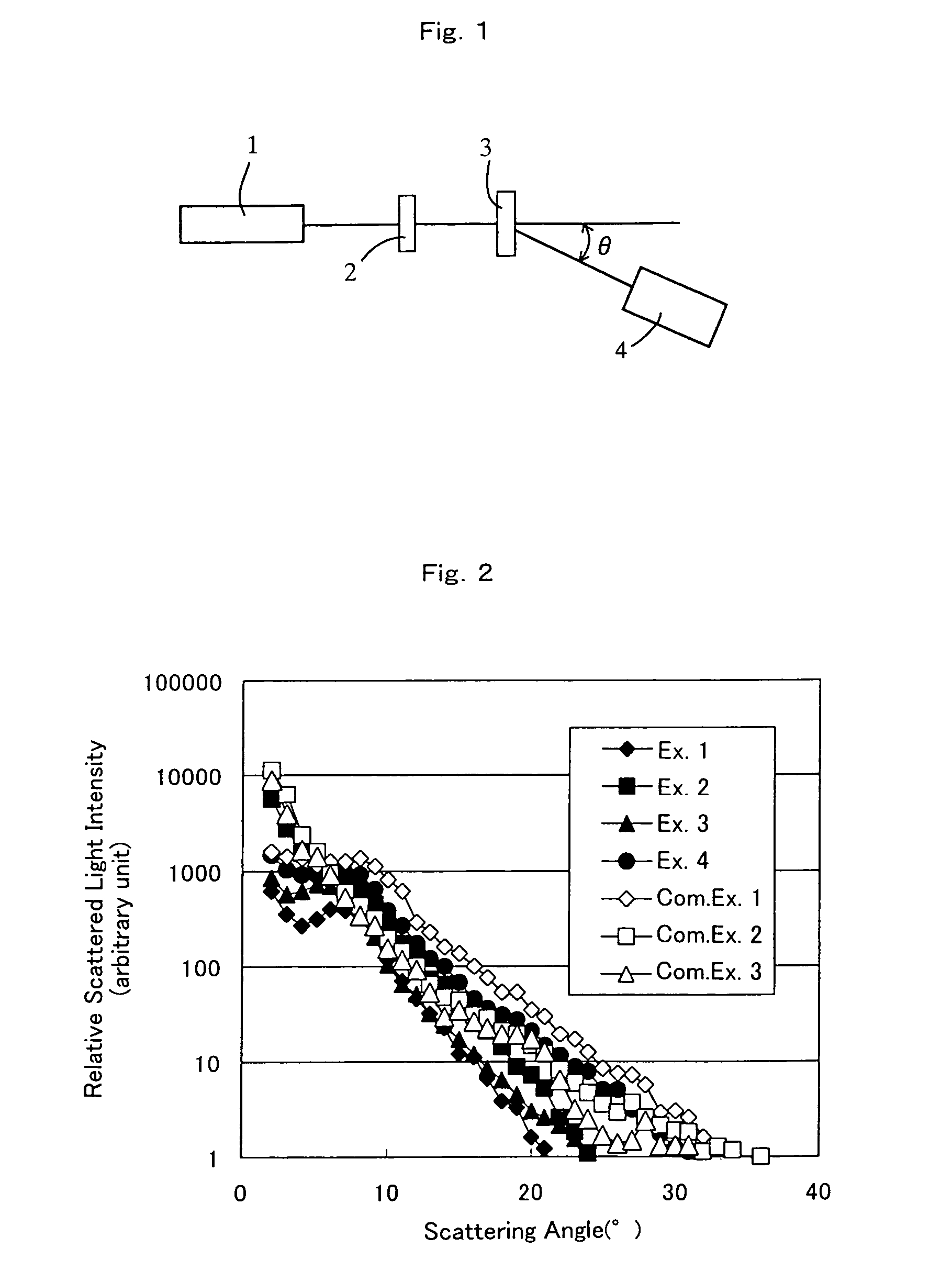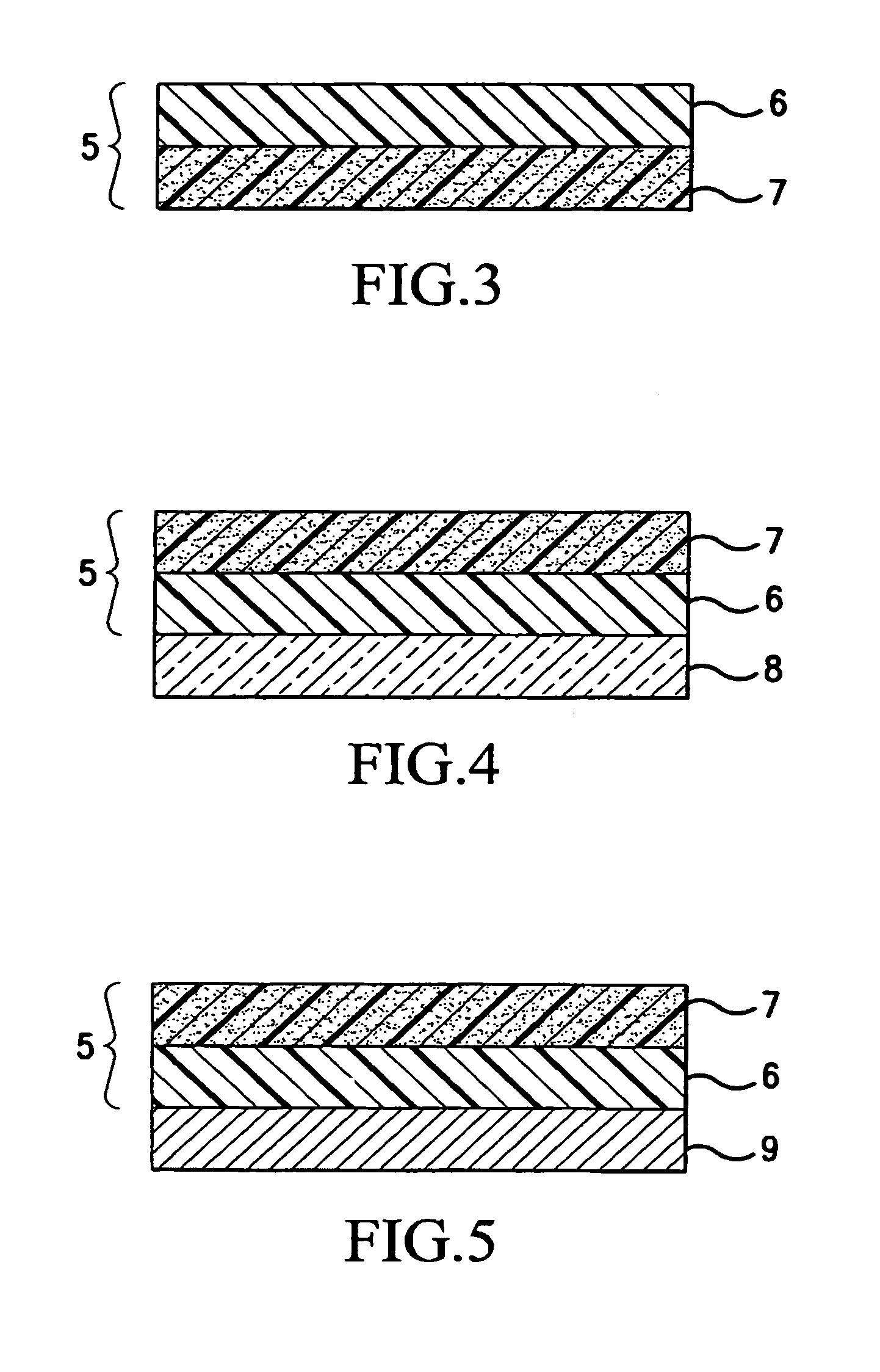Anti-glare film
a film and anti-glare technology, applied in the field of anti-glare (glare proof) film, can solve the problems of debasement of images, glare, and glare, and achieve the effect of preventing the reflection of exterior light, preventing the reflection of surrounding scenery, and high anti-glareness
- Summary
- Abstract
- Description
- Claims
- Application Information
AI Technical Summary
Benefits of technology
Problems solved by technology
Method used
Image
Examples
example 1
[0145]In 37.4 parts by weight of a mixed solvent containing MEK and 1-butanol at the proportion of 8 / 2 [the former / the latter] were dissolved 5.1 parts by weight of an acrylic resin having a polymerizable unsaturated group(s) in a side chain thereof [a compound in which 3,4-epoxycyclohexenylmethyl acrylate is added to part of carboxyl groups in a (meth)acrylic acid-(meth)acrylic acid ester copolymer; manufactured by Daicel Chemical Industries, Ltd., CYCLOMER-P (ACA) 320M, solid content: 48.6% by weight], 1.2 parts by weight of a cellulose acetate propionate (acetylation degree=2.5%, propionylation degree=46%, number average molecular weight in terms of polystyrene: 75000; manufactured by Eastman, Ltd., CAP-482-20), 6.3 parts by weight of a polyfunctional acrylic UV curable monomer (manufactured by Daicel UCB Co., Ltd., DPHA), and 0.6 part by weight of a photo initiator (manufactured by Ciba Specialty Chemicals K.K., IRGACURE 184). This solution was cast on a cellulose triacetate fil...
example 2
[0146]In 37.2 parts by weight of a mixed solvent containing MEK and 1-butanol at the proportion of 8.5 / 1.5 [the former / the latter] were dissolved 5.4 parts by weight of an acrylic resin having a polymerizable unsaturated group(s) in a side chain thereof [a compound in which 3,4-epoxycyclohexenylmethyl acrylate is added to part of carboxyl groups in a (meth)acrylic acid-(meth)acrylic ester copolymer; manufactured by Daicel Chemical Industries, Ltd., CYCLOMER-P (ACA) 320M, solid content: 48.6% by weight], 1.1 parts by weight of a cellulose acetate propionate (acetylation degree=2.5%, propionylation degree=46%, number average molecular weight in terms of polystyrene: 75000; manufactured by Eastman, Ltd., CAP-482-20), 6.3 parts by weight of a polyfunctional acrylic UV curable monomer (manufactured by Daicel UCB Co., Ltd., DPHA), and 0.6 part by weight of a photo initiator (manufactured by Ciba Specialty Chemicals K.K., IRGACURE 184). This solution was cast on a cellulose triacetate film...
example 3
[0147]In 37.3 parts by weight of THF were dissolved 5.3 parts by weight of an acrylic resin having a polymerizable unsaturated group(s) in a side chain thereof [a compound in which 3,4-epoxycyclohexenylmethyl acrylate is added to part of carboxyl groups in a (meth)acrylic acid-(meth)acrylic ester copolymer; manufactured by Daicel Chemical Industries, Ltd., CYCLOMER-P (ACA) 320M, solid content: 48.6% by weight], 1.2 parts by weight of a cellulose acetate propionate (acetylation degree=2.5%, propionylation degree=46%, number average molecular weight in terms of polystyrene: 75000; manufactured by Eastman, Ltd., CAP-482-20), 6.2 parts by weight of a polyfunctional acrylic UV curable monomer (manufactured by Daicel UCB Co., Ltd., DPHA), and 0.6 part by weight of a photo initiator (manufactured by Ciba Specialty Chemicals K.K., IRGACURE 184). This solution was cast on a cellulose triacetate film with the use of a wire bar #30, then the film was allowed to stand in an explosion-proof oven...
PUM
| Property | Measurement | Unit |
|---|---|---|
| total light transmittance | aaaaa | aaaaa |
| haze | aaaaa | aaaaa |
| width | aaaaa | aaaaa |
Abstract
Description
Claims
Application Information
 Login to View More
Login to View More - R&D
- Intellectual Property
- Life Sciences
- Materials
- Tech Scout
- Unparalleled Data Quality
- Higher Quality Content
- 60% Fewer Hallucinations
Browse by: Latest US Patents, China's latest patents, Technical Efficacy Thesaurus, Application Domain, Technology Topic, Popular Technical Reports.
© 2025 PatSnap. All rights reserved.Legal|Privacy policy|Modern Slavery Act Transparency Statement|Sitemap|About US| Contact US: help@patsnap.com



